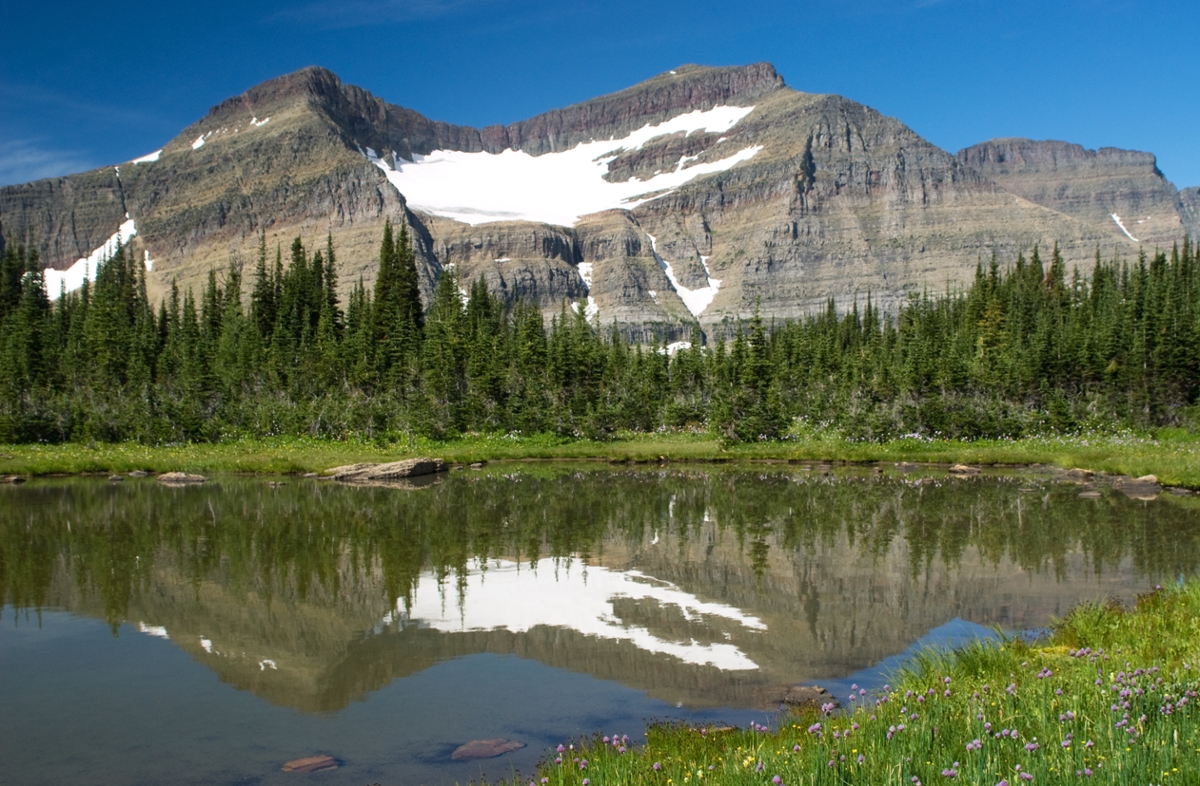Events Reveal Crown of the Continent Timeline
 Water reflects Piegan Glacier in Glacier National Park.
Water reflects Piegan Glacier in Glacier National Park.
It took more than 60 years to create Glacier National Park, which is the foundation of the much larger natural system called the Crown of the Continent that we study and celebrate today. The events that led to the formation of the park and the surrounding ecosystem are regarded today as the bedrock of the conservation movement in America.
What follows then is a timeline as we see it:
1849 – George Bird Grinnell born in Brooklyn, N.Y. – Sept. 20, 1849
George Bird Grinnell was the single most important individual to set in motion actions that would eventually lead to saving Yellowstone and eventually the creation of Glacier National Park. When Grinnell passed away on April 11, 1938, The New York Times called him the “father of the modern day conservation movement.”
The Grinnell family moved to Manhattan and the “Audubon Woods.” The famed John Audubon died in 1851, but as Grinnell grew, John Audubon’s widow, Lucy, taught Grinnell the ways of nature and thus planted the seed that would lead to George’s lifelong involvement in conservation.
In 1870, Grinnell received his bachelor’s degree from Yale. That summer, he was a member of a six-month expedition led by his professor O.C. Marsh to many of the western states, working on fossil collection for the Peabody Museum.
1874 – Grinnell becomes an assistant in osteology (the study of bones and fossils) at the Peabody Museum. He traveled west as a naturalist to the Black Hills of South Dakota.
1875 – Grinnell traveled to the newly created Yellowstone National Park to work as a naturalist for a military reconnaissance. This experience heightened his awareness of the shrinking of wildlife populations.
1876 – Grinnell was named editor of Forest and Stream Magazine, the forerunner to today’s Field and Stream. It was one of the most widely read journals of the time, and, in particular, members of Congress paid attention to Grinnell’s writings and editorials.
1877 – James Willard Schultz came to live amongst the Blackfeet in Montana. He married a Piegan woman, became a prolific writer, guide and hunter, and eventually was adopted into the Blackfeet Nation.
1880 – Grinnell became senior editor and publisher of Forest and Stream and stepped up his editorials in defense of the indigenous peoples and wildlife.
1883 – An Army officer stationed at Fort Browning wrote to the most widely circulated Montana newspaper – The River Press of Fort Benton – exclaiming that the lands that make up today’s Glacier should be set aside as a national park.
1885 – Schultz, now well established amongst the Blackfeet, wrote to Grinnell extolling the virtues of the area revered by the Blackfeet people. His initial query began a long and important connection between the two men.
1885 – In September, Grinnell came to meet Schultz and traveled with him to the lands that would one day become Glacier. Thereafter Grinnell visited the area regularly for 41 years. Their meeting might be considered the most important moment in history of Glacier National Park and hence the Crown.
1885 – Yellowstone National Park increasingly took Grinnell’s attention. The park was endangered from many sides.
1887 – The founding of the Boone and Crockett Club by Grinnell, Teddy Roosevelt and others in December began the serious battles to save Yellowstone as a park and wildlife in general.
1890's – Many achievements, including the 1894 Yellowstone Park Protection Act – often called a keystone of legislation for national park protection, occurred. Forest Reserves were established, including the Flathead and Lewis and Clark – landscapes from which GNP would be carved. Conservation successes in Yellowstone and elsewhere laid the groundwork that would eventually lead to the creation of Glacier National Park.
1893 – Pincher Creek rancher Frederick Godsal sent a proposal to Ottawa to create a national park for the Waterton Lakes area.
1895 – Land was set aside for what would become Waterton Lakes National Park.
1895 – Grinnell participates in the negotiations concerning the Ceded Strip that “purchased” lands from the Blackfeet that would become the east side of the future GNP.
1901 – The Blackfeet people had a name for the mountain landscape of today’s Waterton-Glacier area – “The Backbone of the World.” Grinnell started referring to it as “The Crown of the Continent.”
1907 – GNP legislation is introduced - it took three attempts.
1910 – After much collaboration between conservationists, Grinnell and Louis Hill of the Great Northern Railroad, Glacier National Park was created on May 11.
1932 – Glacier and Waterton receive the distinction of becoming an International Peace Park.
1979 – Waterton/Glacier complex named a UNESCO World Heritage Site.
Since 1910 and in recent years, what is considered the Crown of the Continent expanded as people increasingly recognized natural ecosystems rather than just boundaries.
Rick and Susie Graetz | University of Montana | Department of Geography
